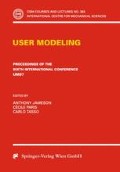Abstract
While user modelling has become a mature field with demonstrable research systems of great power, comparatively little progress has been made in the development of user modelling components for commercial software systems. The development of minimalist user modelling components, simplified to provide just enough assistance to a user through a pragmatic adaptive user interface, is seen by many as an important step toward this goal. This paper describes the development, implementation, and empirical evaluation of a minimalist user modelling component for TIMS, a complex commercial software system for financial management. The experimental results demonstrate that a minimalist user modelling component does improve the subjective measure of user satisfaction. Important issues and considerations for the development of user modelling components for commercial software systems are also discussed.
Special thanks to the EISI team who developed the original TIMS system and provided support for this research.
Access this chapter
Tax calculation will be finalised at checkout
Purchases are for personal use only
Preview
Unable to display preview. Download preview PDF.
References
Chin, J. P., Diehl, V., and Norman, K. (1988). Development of an instrument measuring user satisfaction of the human-computer interface. In CHI’88 Conference Proceedings: Human Factors in Computing Systems. New York: Association for Computing Machinery. 213–218. Available from: http://lap.umd.edu/lapfolder/papers/cdn.html
Kobsa, A. (1993). User modeling: Recent work, prospects and hazards. In Schneider-Hufschmidt, M., Kuhme, T., and Malinowski, U., eds., Adaptive User Interfaces: Principles and Practice. Amsterdam: Elsevier Science Publishers B.V. 111–128.
Krogsaeter, M., Oppermann, R., and Thomas, C. (1994). A user interface integrating adaptability and adaptivity. In Oppermann, R., ed., Adaptive User Support: Ergonomic Design of Manually and Automatically Adaptable Software. Hillsdale, NJ: Lawrence Erlbaum Associates. 97–125.
Krogsaeter, M., and Thomas, C. (1994). Adaptivity: System-initiated individualization. In Oppermann, R. ed., Adaptive User Support: Ergonomic Design of Manually and Automatically Adaptable Software. Hillsdale, NJ: Lawrence Erlbaum Associates. 67–96.
McCalla, G., Searwar, F., Thomson, J., Collins, J., Sun, Y., and Zhou, B. (1996). Analogical user modelling: A case study in individualized information filtering. In Proceedings of UM’96, the Fifth International Conference on User Modeling, 13–20.
McTear, M. (1993). User modelling for adaptive computer systems: A survey of recent developments. Artificial Intelligence Review 7:157–184.
Oppermann, R. (1994). Introduction. In Oppermann, R., ed., Adaptive User Support: Ergonomie Design of Manually and Automatically Adaptable Software. Hillsdale, NJ: Lawrence Erlbaum Associates. 3–12.
QUIS (1997). Available from: http://www.lap.umd.edu/QUISFolder/quisHome.html
Shneiderman, B. (1992). Designing the User Interface: Strategies for Effective Human-Computer Interaction. Reading, MA: Addison-Wesley, 2nd edition.
Strachan, L. (1997). Pragmatic User Modelling for Complex Knowledge-Based Systems. Ph.D. Dissertation, Department of Computer Science, University of Manitoba (forthcoming).
Wong, G., and Rengger, R. (1990). The validity of questionnaires designed to measure user-satisfaction of computer systems. National Physical Laboratory Report DITC 169/90, Teddington, Middlesex, UK.
Author information
Authors and Affiliations
Editor information
Editors and Affiliations
Rights and permissions
Copyright information
© 1997 Springer-Verlag Wien
About this paper
Cite this paper
Strachan, L., Anderson, J., Sneesby, M., Evans, M. (1997). Pragmatic User Modelling in a Commercial Software System. In: Jameson, A., Paris, C., Tasso, C. (eds) User Modeling. International Centre for Mechanical Sciences, vol 383. Springer, Vienna. https://doi.org/10.1007/978-3-7091-2670-7_21
Download citation
DOI: https://doi.org/10.1007/978-3-7091-2670-7_21
Publisher Name: Springer, Vienna
Print ISBN: 978-3-211-82906-6
Online ISBN: 978-3-7091-2670-7
eBook Packages: Springer Book Archive

